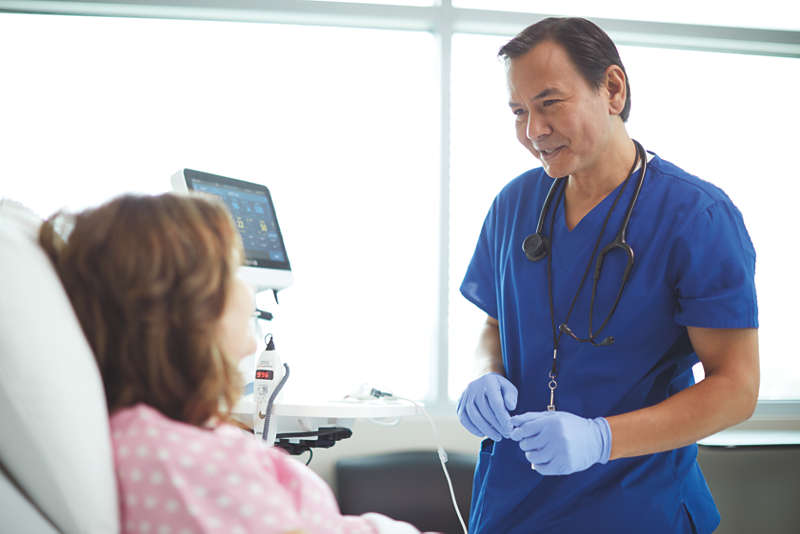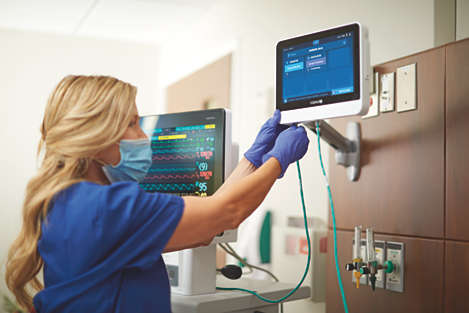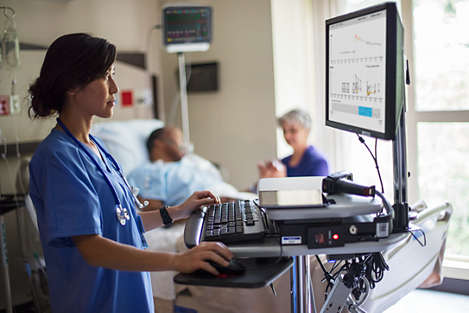Smart Alert: a harbinger of adverse events in critical care settings
Article ∙ By Philips Healthcare ∙ 七月 07, 2023 ∙ 3 min read
Medical device alarms are meant to detect and alert caregivers to life-threatening situations, life-threatening device malfunction, and imminent danger to the patient. Within the critical care setting, however, studies show that more than 87% of device alarms require no medical action or attention.1,2 Philips Capsule can aid healthcare organizations in their pursuit of increased patient safety and improved quality of care through Smart Alerts that might act as a harbinger of adverse events, particularly amidst the critical care settings.
Article at a glance
Nuisance alarms and sensory overload
Medical device alarms are meant to detect and alert caregivers to life-threatening situations, life-threatening device malfunction, and imminent danger to the patient. Within the critical care setting, however, studies show that more than 87% of device alarms require no medical action or attention.1,2 In fact, published literature indicates the rate of actionable or significant alarms is as low as 5% to 13% in intensive care units.2,3,4
The “alarm overload” and constant acoustics associated with audible in-room and remote workstation medical de vice alarms induce a sensory burden for clinicians causing them to become distracted and ignore potentially deadly notifcations.5 This phenomenon is known as alarm fatigue, better defined as the desensitized response by clinicians to overwhelming alarm stimulus, resulting in possible delays to medical action and care.6,7 Clinical alarm management has traditionally focused on the reduction of non-clinically actionable alarms, also known as “nuisance alarms”. Combatting alarm fatigue has been a key challenge in alarm management within the higher acuity settings of healthcare organizations for approximately two decades.
Interim solutions not sustainable
Many healthcare organizations initially opt for practical technology changes in their attempts to reduce alarm fatigue. For example, technological device changes include adjustment to the violation thresholds by which alarms are triggered and alteration to the noise level at which alarms enunciate.8 With evidence-based insights from surveillance monitoring and alarm management systems, healthcare organizations realize that more can be done to reduce the alarm burden. Strategies include instituting delays in alarms signals, tailoring alarm limits to patient age and condition, eliminating the escalation pathway for redundant alarms and more.9 These remedies are interim solutions to the overarching problem, but they do not satisfy the need for recognizing actionable, clinically meaningful notifications above others.
A traditional medical device alarm is a signal that occurs when a measured parameter deviates from accepted thresholds, subject to constraints and conditions on the type, range, and duration of the deviation. An alarm signal may warrant immediate action as the signal enunciates reactively to worsening patient measurements. Yet an alert, through an emergent notification, can indicate that a clinically actionable adverse event may be on the horizon.10 For example, “an alert may occur ten minutes before a patient is expected to deteriorate, while an alarm might indicate asystole.”8
Making alerts more meaningful
A typical medical device alarm indicates a threshold violation of a single measured parameter. The alarm may or may not have significant clinical value; however, the patient care team does not know whether it is actionable or not unless they respond. The combination of the single breached threshold with other contextual information such as data from other measured parameters, or the time window of sustained activity, could inform clinicians as to what is really happening with the patient. For instance, an 80-year-old female who received coronary artery bypass becomes tachycardic. Her tidal volume decreases below 300 liters per minute, as her respiration rate soars above 30 beats per minute. Quickly her chest tube starts filling with blood. Then the ventricular tachycardia (VTACH) alarm goes off. 11
In this scenario several alarms would have been going off concurrently within the environment: High HR…Tachy…Low Tidal Volume…High RR. Alone these alarms would not have been very significant to the clinician, but perhaps if the alerts indicated consecutive high heart measurements over 5 minutes or low tidal volume and high respiration rate occurring simultaneously, then they might have warranted greater attention. Each of these respective examples is highly contextual, with the former indicating heart rate instability and the latter signifying airway obstruction or occlusion. Moreover, this patient may have been particularly burdensome with alarms, causing further desensitization by the clinicians in understanding what is real and what is artifact. This scenario highlights how optimizing the alert itself presents clinicians with a more meaningful notification that grabs their attention and exclaims “the patient needs help.” Instead of responding only when the high priority “VTACH” device alarm was enunciated, the care team could have been administering care much earlier due to an aggregate, contextualized alert incorporating variations in measurements in relation to time elapsed and quantity observed, such as the aforementioned consecutive alert or combination alert. This contextualized, clinically actionable alert is what is called a Smart Alert.

Evolving to smart alerts
Philips Capsule’s Smart Alerts integrate data from multiple modalities including raw measurements, device alarms, and admission discharge transfer (ADT) information for delivery of contextualized emergent notifications. The structure of the Smart Alert algorithm is based on multivariate methods combining variations in measurements in relation to time elapsed and quantity observed. Several types of Smart Alerts have been developed based on specific parameter time trends, such as sustained threshold breaches over a given time duration, consecutively repeated parameter observations over a given time duration, and, finally, simultaneous threshold breaches in separate but coherently evolving parameters in time.
In the critical care setting, many emergent events can occur. Patients in these environments are acutely ill and may be technology dependent (i.e., relying on therapeutic and monitoring equipment to sustain life). Examples of emergent events associated with mechanically ventilated patients include endotracheal tube occlusions, unplanned or unintentional extubation, inability to wean, and ventilator-acquired infection. As an example, unintentional extubation is one of the most common ventilator-related adverse events with an occurrence of up to 10% among mechanically ventilated patients.12,13,14 Unintentional extubation can be characterized either as patient self-extubation or accidental extubation. Agitation or irritation by the patient may give way to self-extubation while accidental extubation can be due to movement of the patient during nursing care or transport for diagnostic procedures.15
Measurement proxies for occlusions and unintentional extubations can include loss of endotracheal pressure, respiration rate, and tidal volume. Violations of all three measurements could be integrated synonymously through a Boolean expression based Smart Alert. Through collaboration with clients, Philips Capsule has curated and investigated various Smart Alerts which suggest the possible occurrence of occlusion and unintentional extubation based upon the measurements obtained from the mechanical ventilator.
In summary, threshold device alarms are simply not enough, as they often produce false positives that have no clinical meaning.5 In contrast, Smart Alerts that utilize algorithms verified and validated against “real-world” data, relating to patient health status, are important in intensive care, particularly for mechanically ventilated patients who are prone to experiencing false positives due to artifact or disconnect.16 Philips Capsule can aid healthcare organizations in their pursuit of increased patient safety and improved quality of care through Smart Alerts that might act as a harbinger of adverse events, particularly amidst the critical care setting.
Footnotes
[1] M. C. Chambrin , P. Ravaux, D. Calvelo-Aros, A. Jaborska, C. Chopin and B. Boniface, “Multicentric study of monitoring alarms in the adult intensive care unit (ICU): a descriptive analysis,” Intesive Care Medicine , vol. 25, no. 12, pp. 1360-1366, 25 Dec 1999.
[2] H. Ruppel, M. Funk and R. Whittemore, “Measurement of Physiological Monitor Alarm Accuracy and Clinical Relevance in Intensive Care Units,” American Journal of Critical Care, vol. 27, no. 1, pp. 11-21, 2018.
[3] S. T. Lawless, “Crying wolf: false alarms in a pediatric intensive care unit,” Critical Care Medicine , vol. 22, no. 6, pp. 981-985, 1994.
[4] E. M. Koski, A. Mäkivirta, T. Sukuvaara and A. Kari, “Frequency and reliability of alarms in the monitoring of cardiac postoperative patients,” Int J Clin Monit Comput, vol. 7, no. 2, 1990.
[5] M. Imhoff and S. Kuhls, “Alarm algorithms in critical monitoring,” Anesthesia and Analgesia , vol. 102, no. 5, pp. 1525-1537, 2006.
[6] P. R. McCartney, “Clinical Alarm Management,” MCN, vol. 37, no. 3, p. 202 , 2012 .
[7] The Joint Commission, “Sentinel Event Alert,” no. 50, 2013.
[8] K. J. Ruskin and J. P. Bliss, “Alarm Fatigue and Patient Safety,” Anaesthesia Patient Safety Foundation Newsletter , vol. 34, no. 1, 2019.
[9] AAMI, “Clinical Alarm Management Compendium,” in National Coalition for Alarm Management Safety , Arlington, 2015.
[10] J. P. Bliss, R. D. Gilson and J. E. Deaton, “Human probability matching behaviour in response to alarms of varying reliability,” Ergonomics, vol. 38, no. 11, pp. 2300-2312, 1995.
[11] J. R. Zaleski, “Doctoral Dissertation,” University of Pennsylvania, 1996.
[12] J. C. Pham, T. L. Williams, E. M. Sparnon, H. F. Scharen and W. M. Marella, “Ventilator-Related Adverse Events: A Taxonomy and Findings From 3 Incident Reporting Systems,” Respiratory Care , vol. 61, no. 5, pp. 621-631, 2016.
[13] P. S. Lucas da Silva and M. C. Machado Fonseca, “Unplanned endotracheal extubations in the intensive care unit: systematic review, critical appraisal, and evidence-based recommendations,” Anesth Analg, vol. 114, no. 5, pp. 1003-1014, 2012.
[14] T. Boulais, “Unplanned extubations in the adult intensive care unit: a prospective multicenter study. Association des Réanimateurs du Centre-Ouest,” Am J Respir Crit Care Med, vol. 157, no. 4, pp. 1131-1137, 1998.
[15] L. Berkow and A. Kanowitz, “Unplanned Extubation A Common and Costly Complication of Airway Management,” Patient Safety Authority, 2020.
[16] FDA, “Real-World Evidence,” FDA, Washington D.C., 2020


